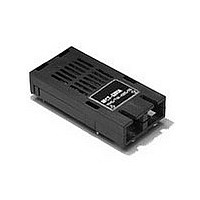HFCT5201B Avago Technologies US Inc., HFCT5201B Datasheet - Page 4

HFCT5201B
Manufacturer Part Number
HFCT5201B
Description
Manufacturer
Avago Technologies US Inc.
Datasheet
1.HFCT5201B.pdf
(8 pages)
Specifications of HFCT5201B
Optical Fiber Type
TX/RX
Data Transfer Rate
155Mbps
Operating Temperature Classification
Commercial
Peak Wavelength
1360nm
Operating Supply Voltage (min)
4.75V
Operating Supply Voltage (typ)
5V
Operating Supply Voltage (max)
5.25V
Output Current
30mA
Operating Temp Range
0C to 70C
Pin Count
18
Lead Free Status / RoHS Status
Not Compliant
due to the 0.2 V difference in supply levels. Also, noise
immunity may be compromised for the HFCT‑5201 trans‑
ceiver because the ground plane is now the V
point. The suggested power supply filter circuit shown
in Figure 4, Recommended Circuit Schematic, should
be located in the V
pins. Direct coupling of the differential data signals can
be done between the HFCT‑5201 transceiver and the
standard ECL circuits.
Recommended Solder and Wash Process
The HFCT‑5201 is compatible with industry standard
wave or hand solder processes.
HFCT-5201 Process Plug
The HFCT‑5201 transceiver is supplied with a process
plug for protection of the optical ports with the Duplex
SC connector receptacle. This process plug prevents
contamination during wave solder and aqueous rinse as
well as during handling, shipping or storage. It is made
of high‑temperature, molded, sealing material.
Recommended Solder Fluxes and Cleaning/Degreasing
Chemicals
Solder fluxes used with the HFCT‑5201 fiber‑optic trans‑
ceiver should be water‑soluble, organic solder fluxes.
Some recommended solder fluxes are Lonco 3355‑11
from London Chemical West, Inc. of Burbank, CA, and 100
Flux from Alpha‑ metals of Jersey City, NJ.
Recommended cleaning and degreasing chemicals for
4
Figure 5. Recommended Board Layout Hole Pattern
33.02
(1.3)
(0.1)
2.54
2.54
(0.1)
EE
paths at the transceiver supply
20.32
(0.8)
TOP
VIEW
18 x Ø 0.8 ± 0.1
(0.032 ± 0.004)
(0.075 ± 0.004)
2 x Ø 1.9 ± 0.1
CC
supply
the HFCT‑5201 are alcohol’s (methyl, isopropyl, isobutyl),
aliphatics (hexane, heptane) and other chemicals, such
as soap solution or naphtha. Do not use partially haloge‑
nated hydrocarbons for cleaning/degreasing. Examples
of chemicals to avoid are 1.1.1. trichloroethane, ketones
(such as MEK), acetone, chloroform, ethyl acetate,
methylene dichloride, phenol, methylene chloride or
N‑methylpyrolldone.
Regulatory Compliance
The HFCT‑5201 is intended to enable commercial system
designers to develop equipment that complies with the
various regulations governing certification of Information
Technology Equipment. See the Regulatory Compliance
Table 1 for details. Additional information is available
from your Avago sales representative.
Electrostatic Discharge (ESD)
There are two design cases in which immunity to ESD
damage is important.
The first case is during handling of the transceiver prior
to mounting it on the circuit board. It is important to
use normal ESD handling precautions for ESD sensitive
devices. These precautions include using grounded wrist
straps, work benches and floor mats in ESD controlled
areas.
The second case to consider is static discharges to the
exterior of the equipment chassis containing the trans‑
ceiver parts. To the extent that the duplex SC connector
is exposed to the outside of the equipment chassis it may
be subject to whatever ESD system level test criteria that
the equipment is intended to meet.
Electromagnetic Interference (EMI)
Most equipment designs utilizing these high‑speed
transceivers from Avago will be required to meet the
requirements of FCC in the United States, CENELEC
EN55022 (CISPR 22) in Europe and VCCI in Japan.
The HFCT‑5201 has been characterized without a chassis
enclosure to demonstrate the robustness of the part’s
integral shielding. Performance of a system contain‑
ing these transceivers within a well designed chassis is
expected to be better than the results of these tests with
no chassis enclosure.
Immunity
Equipment utilizing these HFCT‑5201 transceivers will
be subject to radio‑frequency electromagnetic fields
in some environments. These transceivers, with their
integral shields, have been characterized without the
benefit of a normal equipment chassis enclosure and
the results are reported below. Performance of a system
containing these transceivers within a well designed
chassis is expected to be better than the results of these
tests without a chassis enclosure.

















